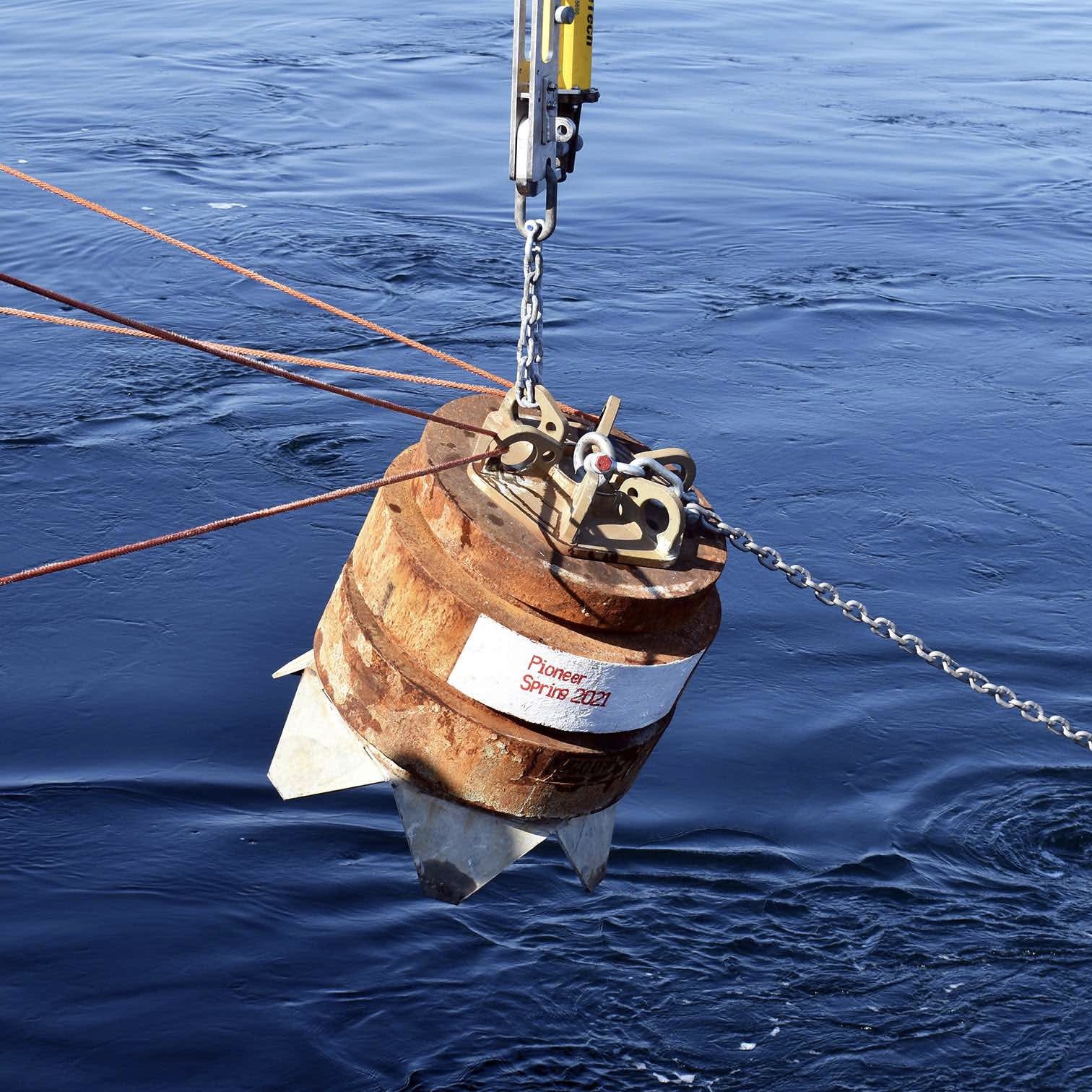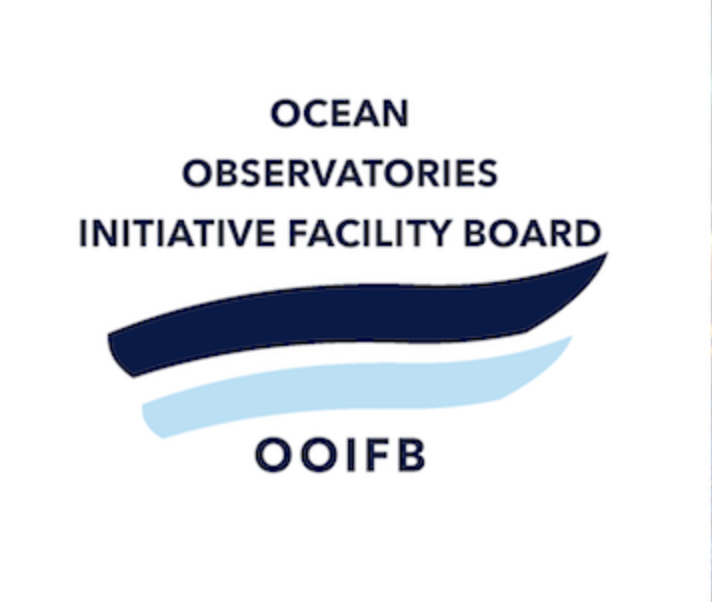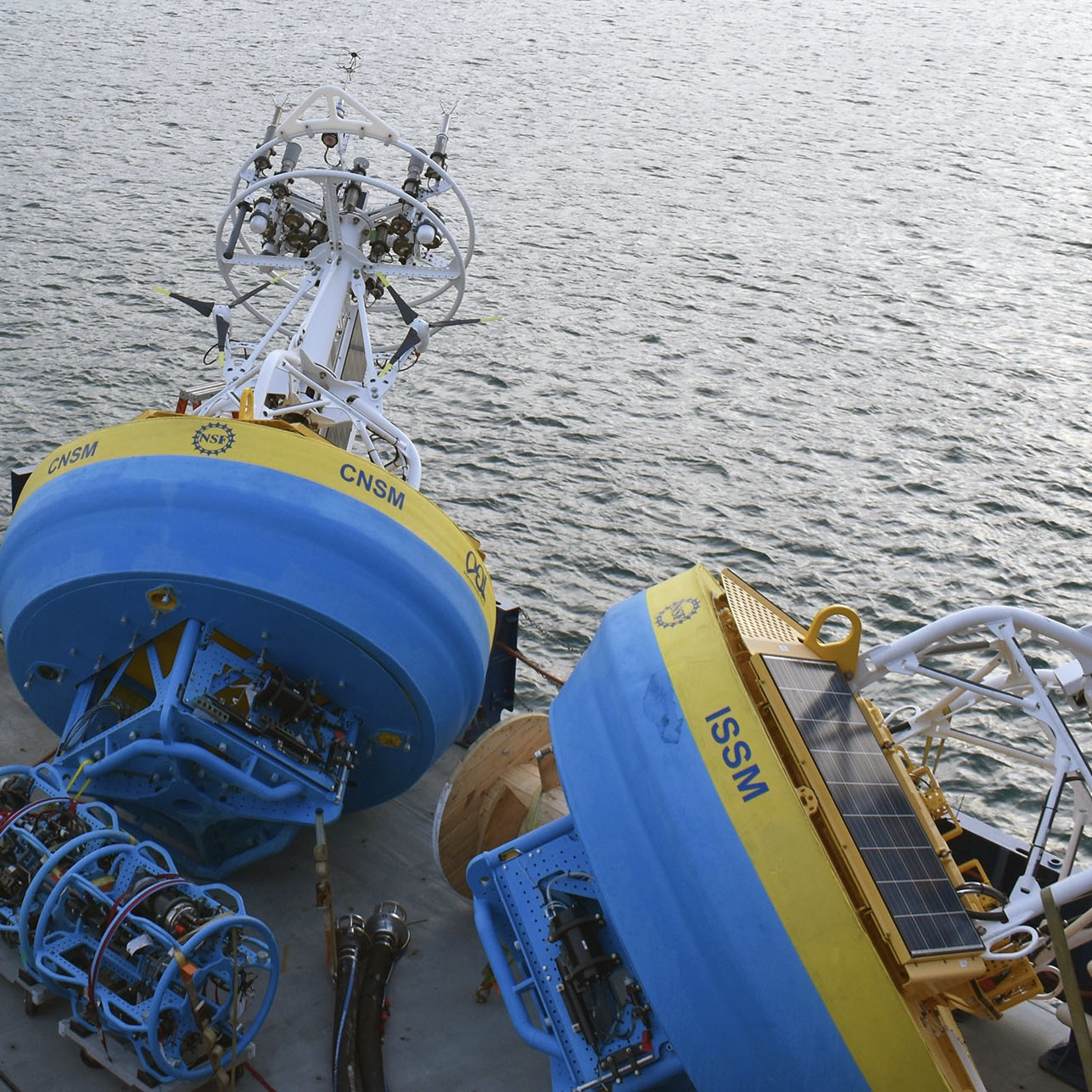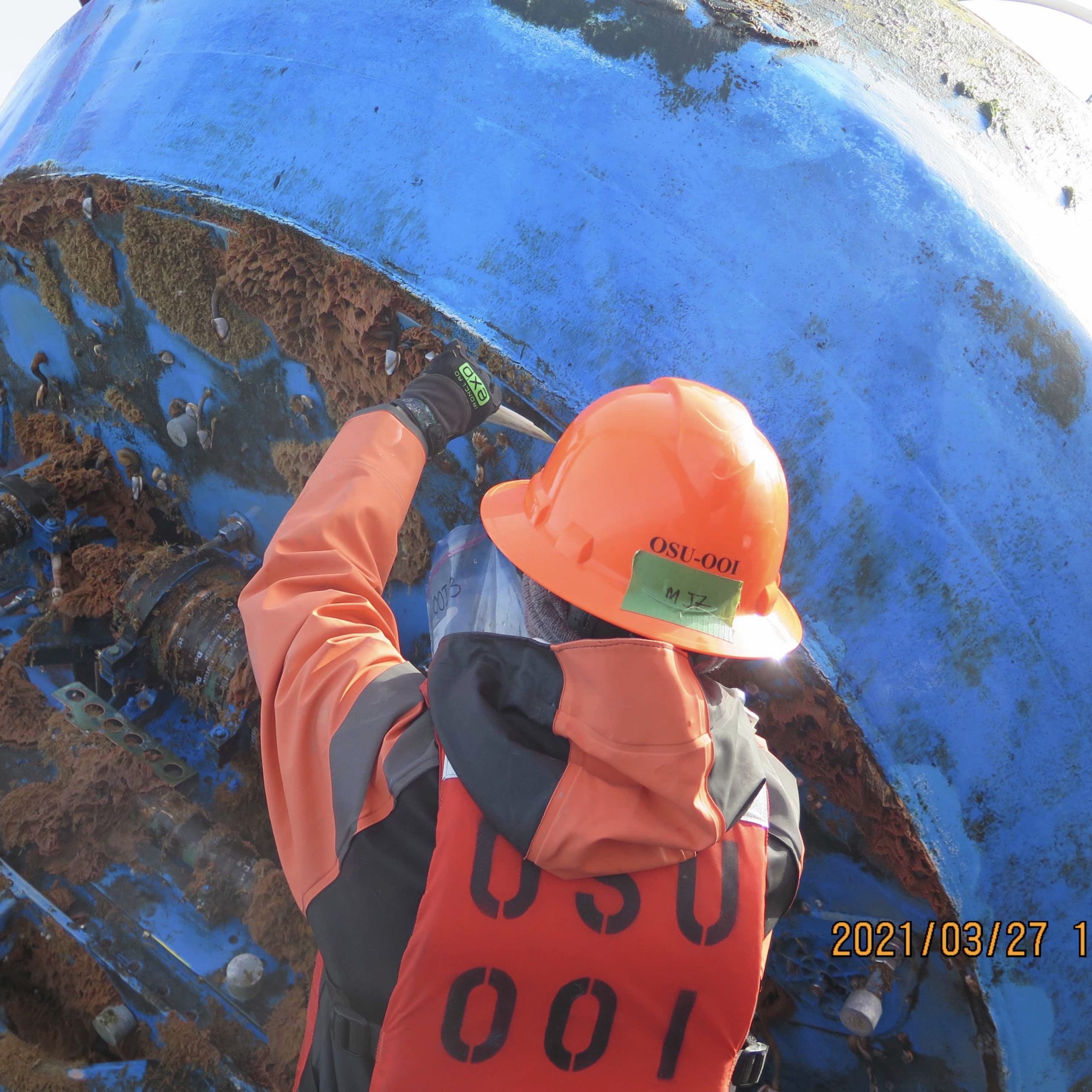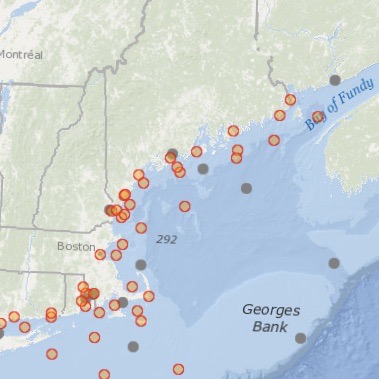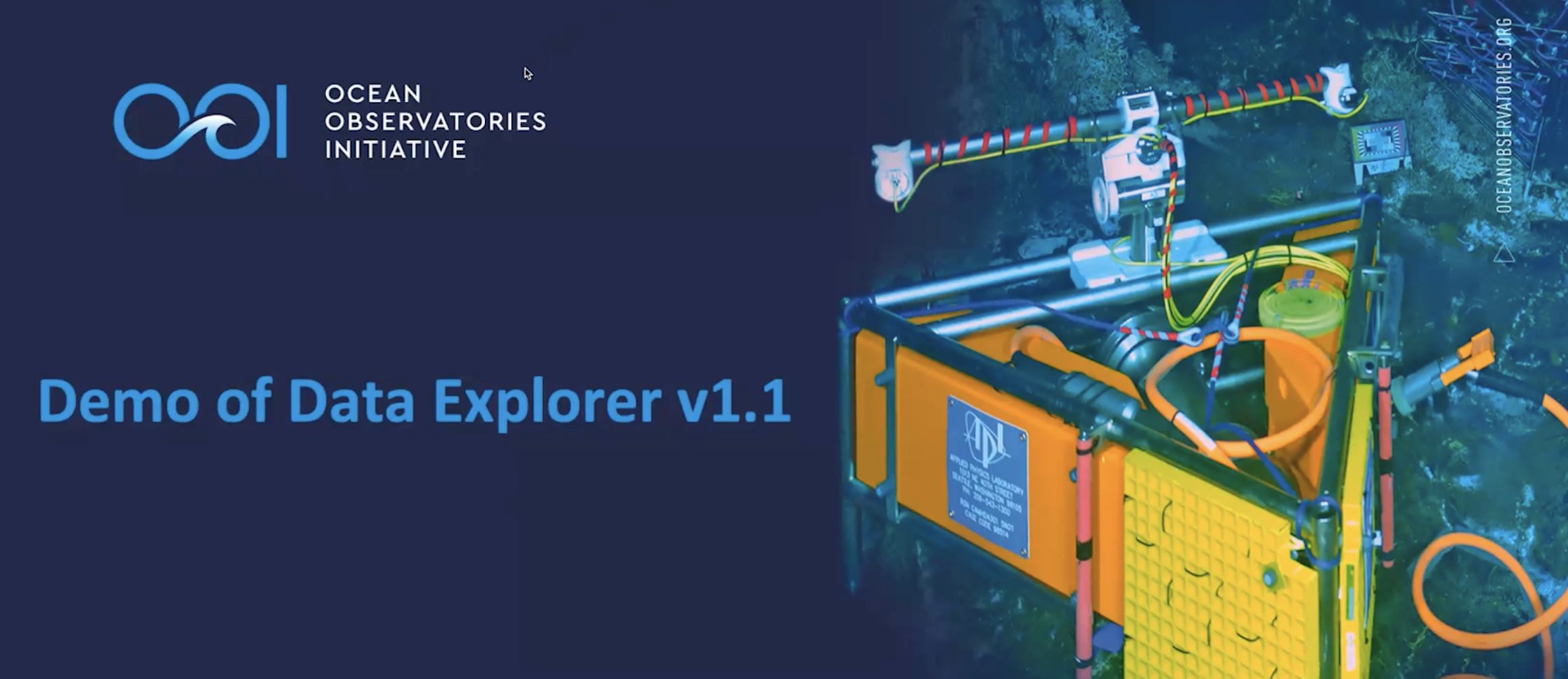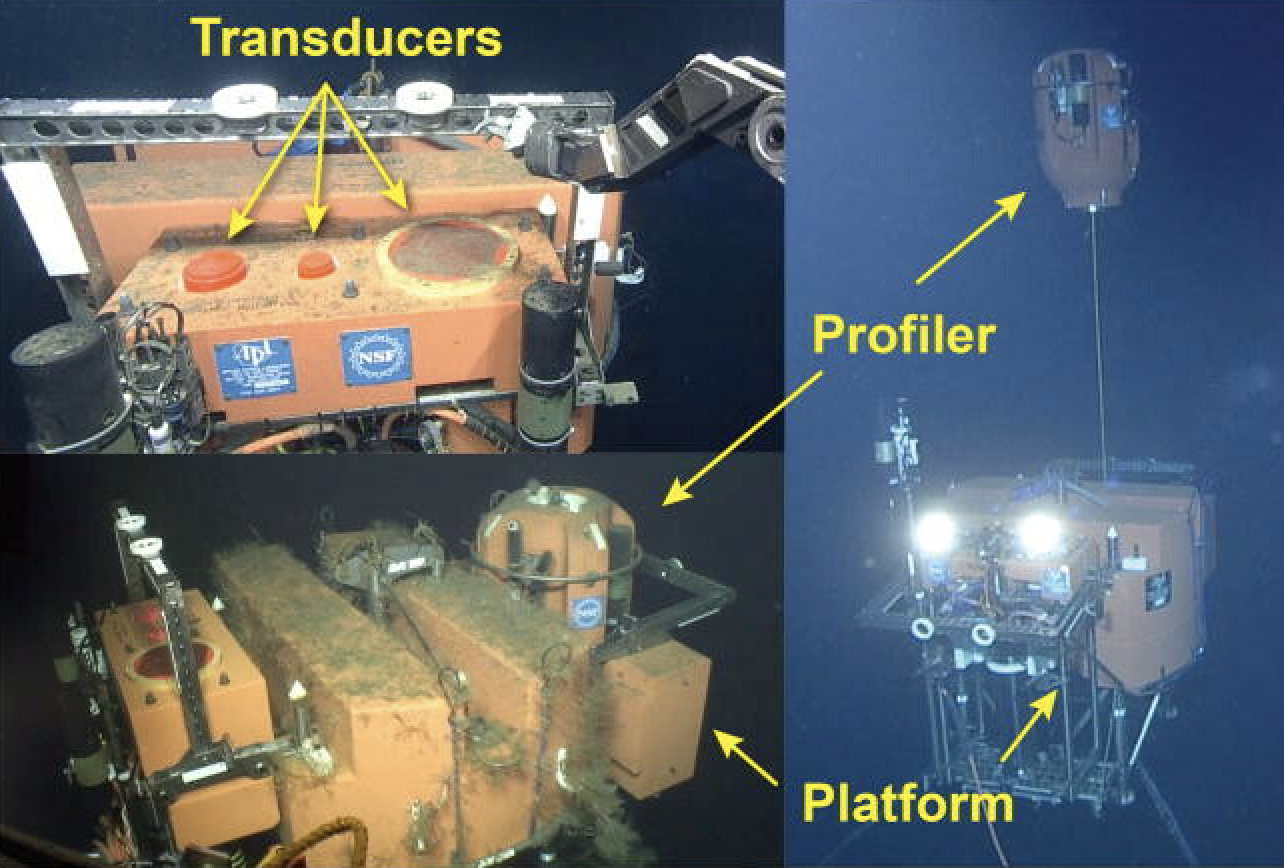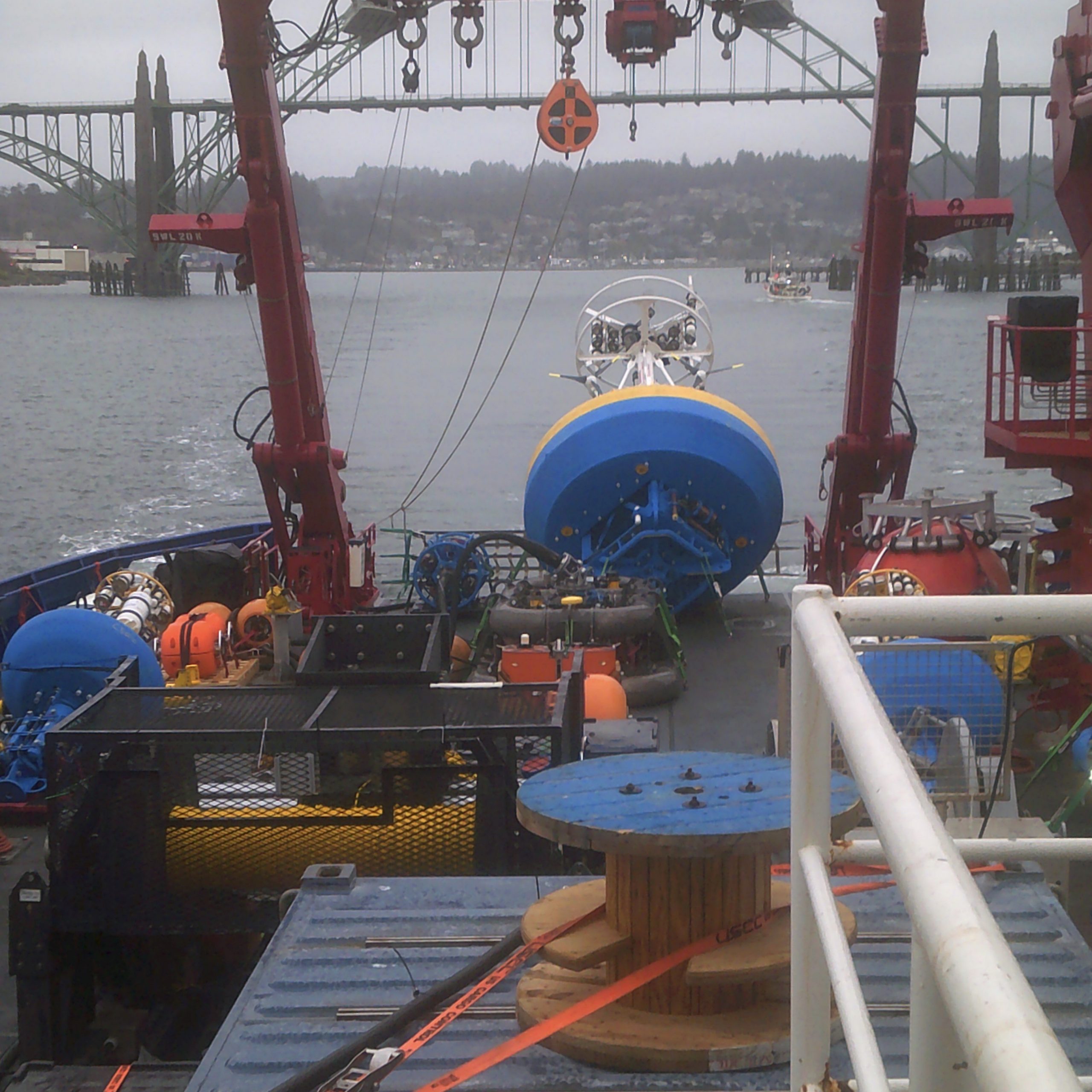News
OOI Pioneer Array to Relocate to MAB
It’s official, the next location of the OOI (Ocean Observatories Initiative) Coastal Pioneer Array is the Mid-Atlantic Bight (MAB) and the move will take place in 2024. The geographic footprint championed during the NSF-sponsored Innovations Lab #1 is the region of the MAB between Cape Hatteras and Norfolk Canyon. This region offers opportunities to collect data on a wide variety of cross-disciplinary science topics including cross-shelf exchange, land-sea interactions associated with large estuarine systems, a highly productive ecosystem with major fisheries, and carbon cycle processes. This location also offers opportunities to improve our understanding of hurricane development, tracking and prediction, and offshore wind partnerships.
As background, the OOI has been in full operations since 2016. The OOI Pioneer Array was designed to be relocatable, and in 2020 the Ocean Observatories Initiative Facilities Board (OOIFB) and the National Science Foundation (NSF) launched a process to select the next OOI Pioneer Array location. A Phase 1 Innovations Lab was held in March 2021 to explore possible locations based on scientific questions of interest. The inputs received helped NSF make its decision to select the MAB.
A second (Phase 2) Innovations Lab is scheduled for the week of June 21-25. During this Lab, participants will work to further identify and refine the opportunities afforded by the new Pioneer Array location. Selected participants will be exploring how the Pioneer Array sensors and platforms can be optimized to achieve science and education goals at the new site, based on environmental, logistical, and infrastructural considerations. Partnership and collaboration potentials at the new location will also be discussed. The OOIFB, in partnership with Know Innovations, will again be facilitating the second Innovation Lab.
There is also an open to all Microlab scheduled for May 12th if you are intrigued and want to learn more: (https://ooifb.org/meetings/pioneer-array-phase2/).
The ocean community is invited to help identify new design considerations that can enable exciting research endeavors at the chosen location. Scientists, educators, and other stakeholders are encouraged to apply for the Phase 2 Innovations Lab. Please visit the OOIFB website for more information.
Read More
Expanding Reach of OOI Data
 Pioneer Array data is now available on NERACOOS’ new Mariner’s Dashboard. This is but one example of how OOI data are integrated into other data repositories to maximize their benefit and use.[/caption]
Pioneer Array data is now available on NERACOOS’ new Mariner’s Dashboard. This is but one example of how OOI data are integrated into other data repositories to maximize their benefit and use.[/caption]
OOI shares data with partner repositories and institutions that host similar data but have different user bases. These partnerships expand the data available for forecasting models, help provide insight into current ocean conditions, and serve as important resources for many ranging from fishers and other maritime users to land-based researchers and students.
With the exception of the Station Papa Array, the OOI Coastal and Global Arrays maintain surface buoys. Instruments deployed on these buoys measure meteorological variables such as air temperature, barometric pressure, northward and eastward wind velocities, precipitation, solar radiation, and surface water properties of sea surface temperature and salinity. Other instruments on the moorings collect wave data, such as significant wave height, period, and direction. These data are then consumed by national and regional networks to improve accuracy of weather forecasting models.
The Regional Cabled Array (RCA) consists of fiber-optic cables off the Oregon coast that provide power, bandwidth, and communication to seafloor instrumentation and moorings with instrumented profiling capabilities. A diverse array of geophysical, chemical, and biological sensors, a high-definition camera, and digital still cameras on the seafloor and mooring platforms, provide real-time information on processes operating on and below the seafloor and throughout the water column, including recording of seafloor eruptions, methane plume emissions and climate change. These data are available for community use. Since 2015, the RCA has fed data into Incorporated Research Institutions for Seismology (IRIS), the primary source for data related to earthquakes and other seismic activity. In addition, data including zooplankton sonar data, are being utilized within the Pangeo ecosystem for community visualization and access and pressure data are incorporated into NOAA’s operational tsunami forecasting system.
Helping Improve Models and Forecasting
One of the recipients of OOI data is the National Data Buoy Center (NDBC), part of the National Oceanic and Atmospheric Administration’s (NOAA) National Weather Service. NDBC maintains a data repository and website, offering a range of standardized real-time and near real-time meteorological data. Data such as wind speed and direction, air and surface water temperature, and wave height and direction are made available to the broader oceanographic and meteorological community.
“Many researchers go to NDBC for their data, “said Craig Risien, a research associate with OOI’s Endurance Array and Cyberinfrastructure Teams, who helps researchers gain access to and use OOI data. “NBDC is a huge repository of data and it’s easy to access. So there’s a low barrier for researchers and students who are looking for information about wind speed, water temperature and a slew of other data. OOI contributing to this national repository significantly increases its data reach, allowing OOI data to be used by as many people as possible. “
OOI sea surface temperature data also make their way into the operational Global Real-Time Ocean Forecast System (RTOFS) at the National Centers for Environmental Prediction (NCEP), another part of NOAA’s National Weather Service. RTOFS ingests sea surface temperature and salinity data from all available buoys into the Global Telecommunications System (GTS). OOI glider data also are pushed in near real-time to the US Integrated Ocean Observing System Glider Data Assembly Center (DAC). From there, the data goes to the GTS where it can be used by the operational modeling centers such as NCEP and the European Centre for Medium-Range Weather Forecasts.
The GTS is like a giant vacuum sucking up near real-time observations from all sorts of different platforms deployed all over the world. On a typical day, the GTS ingests more than 7,600 data points from fixed buoys alone. As a result of this vast input, researchers can go to the GTS, pull available data, and assimilate that information into any model to improve its prediction accuracy.
Advancing Forecasting of Submarine Eruptions
As the first U.S. ocean observatory to span a tectonic plate, RCA’s data are an invaluable contributor to IRIS’s collection. Since 2015, the user community has downloaded >20 Terabytes of RCA seismometer data from the IRIS repository. Fourteen different sampling locations include key sites at Axial Seamount on the Juan de Fuca mid-ocean ridge spreading center, near the toe of the Cascadia Margin and Southern Hydrate Ridge. RCA data are catalogued and available on the IRIS site, using the identifier “OO.”
[caption id="attachment_21046" align="alignleft" width="300"]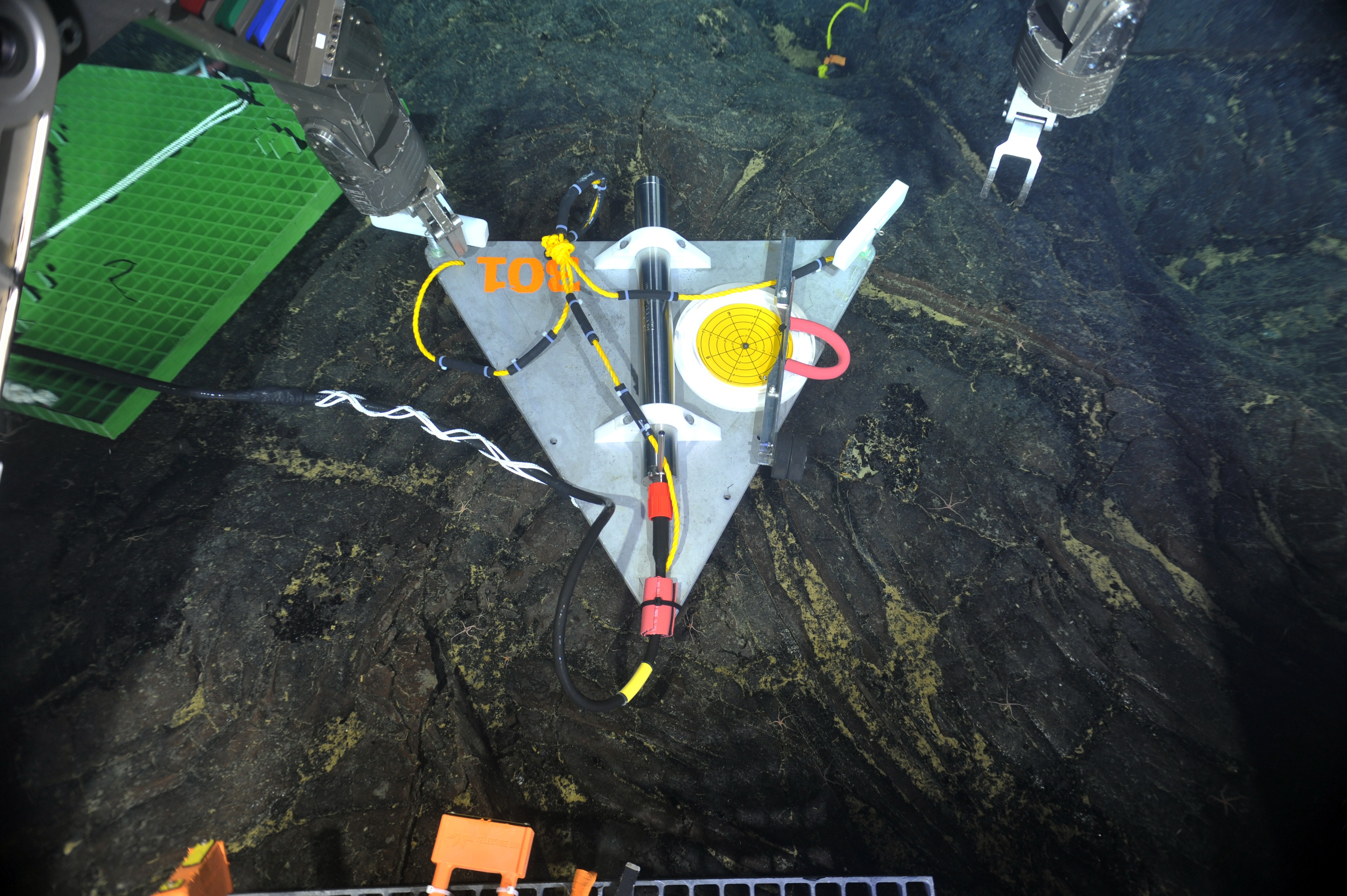 Data from short period seismometers installed at RCA’s Axial Seamount and Southern Hydrate Ridge sites are streamed live to IRIS. Credit: UW/NSF-OOI/Canadian Scientific Submersible Facility, V13.[/caption]
Data from short period seismometers installed at RCA’s Axial Seamount and Southern Hydrate Ridge sites are streamed live to IRIS. Credit: UW/NSF-OOI/Canadian Scientific Submersible Facility, V13.[/caption]
“RCA is a critical community resource for seismic data. Axial Seamount, for example, which erupted in 1998, April 2011, was the site of more than 8,000 earthquakes over a 24-hour period April 24, 2015 marking the start of large eruption,” explained Deb Kelley, PI of the RCA. “Being able to witness and measure seismic activity in real time is providing scientists with invaluable insights into eruption process, which along with co-registered pressure measurements is making forecasting possible of when the next eruption may occur. We are pleased to share data from this volcanically and hydrothermally active seamount so researchers the world over can use it to better understand processes happening at mid ocean ridges and advance forecasting capabilities for the first time of when a submarine eruption may occur.”
Providing Data with Regional Implications
[caption id="attachment_21047" align="alignright" width="203"]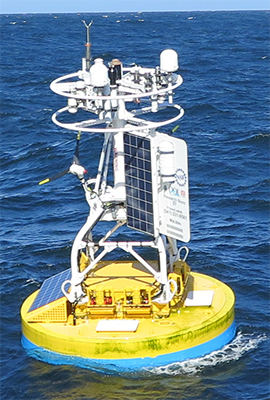 Data from Endurance Array buoy 46100 are fed into WCOFS, where they are accessible to maritime users. Credit: OSU[/caption]
Data from Endurance Array buoy 46100 are fed into WCOFS, where they are accessible to maritime users. Credit: OSU[/caption]
OOI also provides data to regional ocean observing partners. Data from two Endurance Array buoys (46099 and 46100), for example, are fed into a four-dimensional U.S. West Coast Operational Forecast System (WCOFS), which serves the maritime user community. WCOFS generates water level, current, temperature and salinity nowcast and forecast fields four times per day. The Coastal Pioneer Array is within the future Northeastern Coast Operational Forecast System (NECOFS). Once operational, Pioneer’s observations will potentially be used for WCOFS data assimilation scenario experiments.
Coastal Endurance Array data are shared with the Northwest Association of Networked Ocean Observing Systems (NANOOS), which is part of IOOS, and the Global Ocean Acidification Observing Network (GOA-ON). Endurance data are ingested by the NANOOS Visualization System, which provides easy access to observations, forecasts, and data visualizations. Likewise, for GOA-ON, the Endurance Array provides observations useful for measuring ocean acidification.
Data from three of the Pioneer Array buoys also are part of the Mariners’ Dashboard, a new ocean information interface at the Northeastern Regional Association of Coastal Ocean Observing Systems (NERACOOS). Visitors can use the Dashboard to explore the latest conditions and forecasts from the Pioneer Inshore (44075), Central (44076), and Offshore (44077) mooring platforms, in addition to 30+ other observing platforms throughout the Northeast.
“We are working hard to distribute the OOI data widely through engagement with multiple partners, which together are helping inform science, improve weather and climate forecasts, and increase understanding of the ocean,” added Al Plueddemann, PI of the Coastal and Global Scale Nodes, which include the Pioneer, Station Papa, and Irminger Sea Arrays.
Read More
Call for Applications: OOIFB Data Systems Committee
Application Deadline: May 20, 2021
The Data Systems Committee (DSC) of the NSF Ocean Observatories Initiative Facility Board (OOIFB) was established to help ensure timely and reliable access to high-quality Ocean Observatories Initiative (OOI) data. The Committee evaluates and recommends improvements to the data services policies and practices of the OOI Facility that will lead to more efficient and effective scientific use of OOI data.
The DSC is now soliciting applications to fill one open position. The appointment will fill the remainder of an unexpired term and will be effective starting in May 2021 and run through September 2023. The selected individual will be eligible to serve a second term of 3-years. The DSC holds at least one in-person meeting per year and one web conference each month.
Some of the objectives of the committee include:
- Keeping abreast of the current state of the OOI cyberinfrastructure and data services with the goal of helping to promote maximum scientific use of OOI data. These efforts will be informed by the FAIR Guiding Principles for scientific data management and stewardship, such that data are: a) Findable, b) Accessible, c) Interoperable, and d) Reusable.
- Encouraging the use of best practices, standards, and naming conventions established by the oceanographic community.
- Engaging with the user community to gauge user needs in regard to OOI data systems, and to facilitate the promotion of a positive user experience.
- Staying current on potential new modes of data service and access, data analysis methodologies, and related technologies that facilitate the use of OOI data.
- Engaging with the OOI Program team regarding the priorities and plans of the OOI cyberinfrastructure groups.
- Making recommendations for data products, usage metrics, and improving the user experience on the OOI Data Explorer, as well as other data service systems employed by the OOI.
Scientists with experience using scientific observing systems such as OOI, as well as those with experience in successfully delivering data from large-scale multi-sensor observing systems to scientific users are encouraged to apply. Applications should be submitted to Annette DeSilva, at the OOIFB Administrative Support Office (desilva@ooifb.org), and must include a letter of interest and an academic CV.
Applications are due by May 20, 2021. Applications will be reviewed by the DSC members who will give due consideration to the qualifications of applicants, as well as to maintenance of career level, disciplinary, and regional balance on the Committee. For more information about the DSC and its activities, please visit the OOIFB website or contact Tim Crone, DSC Chair (tjcrone@gmail.com).
Read MoreSweet 16: Pioneer Array Successfully Turned
Twenty days at sea. Forty different at-sea operations. Nine moorings recovered. Eight moorings, two coastal profiling gliders and two global test gliders deployed. Completion of more than 25 objectives during the 16th turn of the Coastal Pioneer Array.
By all counts, the Pioneer Array 16 expedition was a huge success. The scientific team was able to accomplish a full mooring service cruise in spite of COVID-imposed restrictions that restricted building occupancy for pre-cruise preparation, limited personnel onboard to accomplish the work and imposed a two-week quarantine period prior to boarding the ship.
“It’s always takes a focused effort from many people for a successful cruise, but COVID has made it harder.” said Al Plueddemann, chief scientist for Pioneer Array and principal investigator for the Ocean Observatory Initiative’s (OOI) Coastal and Global Scale Nodes. “The OOI team, the captain and crew of the Armstrong, and the shore-side support all put in a great effort to see this through to completion, while still operating at reduced efficiency under ongoing COVID-19 restrictions.”
A variety of atmospheric and oceanographic measurements are made prior to deployments and following recoveries for validation of mooring, glider, and AUV (autonomous underwater vehicle) observations. The team also conducted cross-shelf and along-shelf CTD surveys and collected water samples adjacent to all the moorings. The team also surveyed the array’s region using shipboard sensors (ADCP, EK-80, and thermosalinograph).
In addition to the successful mooring operations, the Pioneer 16 team completed several mobile platform objectives as well. For the spring and summer time period, two coastal profiling gliders were deployed to replace winter profiler moorings. Two global test gliders were also put through their paces to ensure safe operation and reliable data delivery prior to operations at a global array. Two AUVs were launched and traveled pre-determined paths around the array before being recovered and having their data downloaded. While the team was following the AUVs to ensure the missions were progressing as planned, they encountered a pod of about 40 pilot whales that included both young and adult whales. The team and the pod of whales were equally fascinated by each other. Both groups stopped to observe the other’s behaviors.
[caption id="attachment_20931" align="alignleft" width="300"]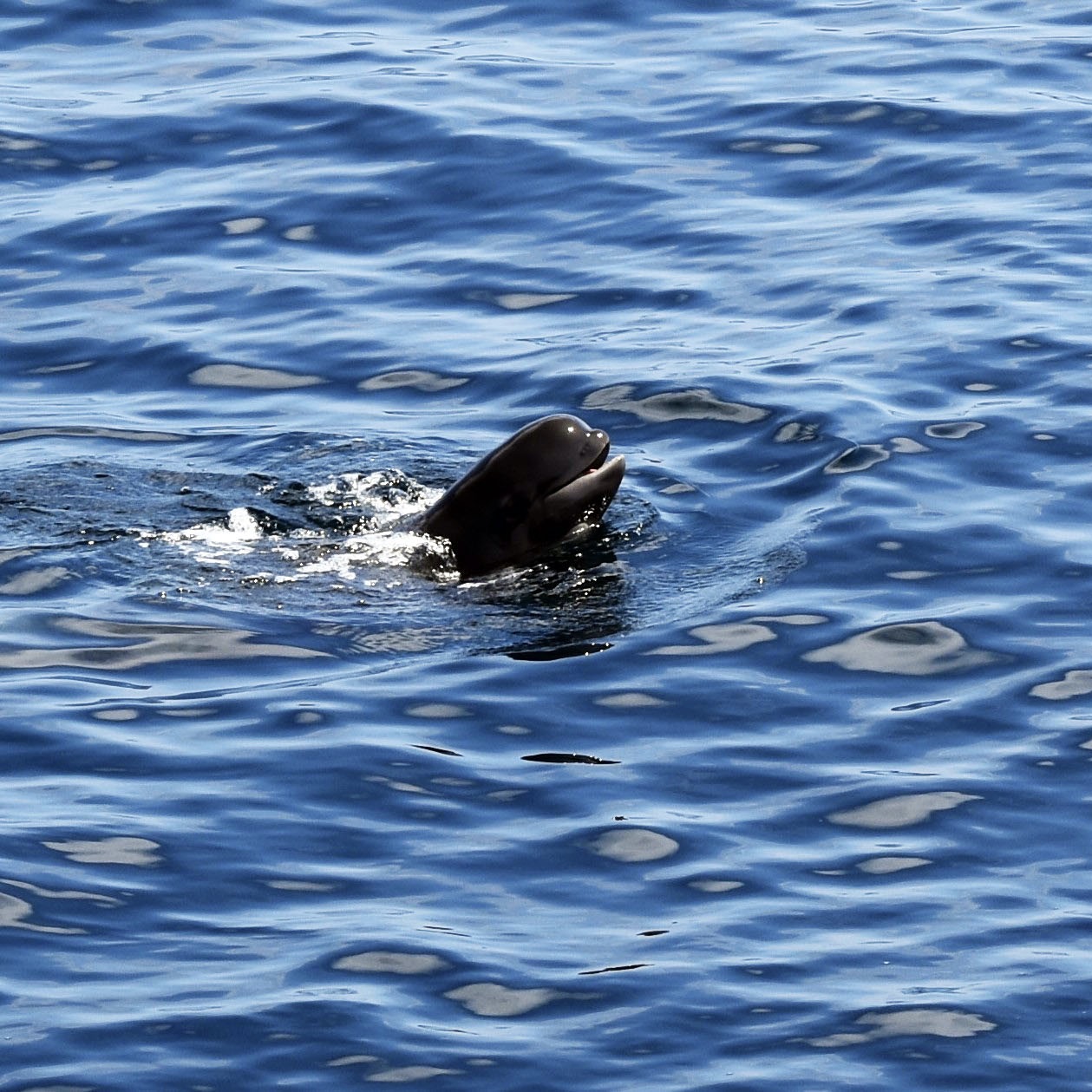 Photo: Rebecca Travis©WHOI.[/caption]
Photo: Rebecca Travis©WHOI.[/caption]
“The data we collect are helping scientists better understand the ocean environment and how it is changing. Seeing the pilot whales reminded us of the importance of these observations, and the research they enable, to the marine ecosystem.” added Plueddemann.
Read More
Mission Accomplished: Endurance 14 Cruise Meets All Objectives
After a 15-day expedition, the Endurance Array Team returned to port aboard the R/V Sikuliaq on 7 April having successfully completed the 14th turn of the Endurance Array. The team recovered and deployed seven surface moorings and completed sampling at all recovery/deployment sites. They also deployed and recovered gliders and surface profilers.
Because of the size and weight of the moorings and other equipment, the trip was conducted in two legs. The first leg was primarily off Washington and the second off Oregon. Between legs, the R/V Sikuliaq returned to Newport, Oregon to offload recovered equipment from the Washington Line and load new equipment for the Oregon Line.
The weather was rough when the R/V Sikuliaq first set off from Newport on 24 March. On the first night out, they saw 19-foot waves and 35-knot winds. The team worked around the weather on the first leg to deploy three moorings and recover four. They also recovered and deployed gliders.
The second leg of the journey brought with it much better weather, which eased the recoveries, deployments, sampling, and other activities. During this leg, the team worked mostly off Oregon. The team deployed four moorings and three profilers and recovered three moorings, three gliders, and a profiler.
Each OOI deployment brings some technical improvement. On this deployment, the Endurance moorings are outfitted with redesigned solar panels on the buoy decks. These panels will deliver more power and be more resilient to wear and tear caused by sea lions who often find the buoys an inviting place to lounge. The redesign was implemented by OOI’s Coastal and Global Scale Nodes team at Woods Hole Oceanographic Institution.
This trip also marked the Endurance Array’s team first use of a OOI’s ROV (remotely operated vehicle). The ROV was used at the Oregon shelf site to recover a coastal surface piercing profiler and its anchor. Throughout the process, the R/V Sikuliaq maneuvered skillfully to place the ship over the target. Mooring lead Alex Wick piloted the ROV through strong currents and limited visibility. It took four dives, but the profiler and its anchor were recovered. On the third dive, the ROV was used to cut the winch line so the team could recover the profiler, and the anchor was recovered on the fourth and final dive.
The Endurance team also collected CTD samples and biofouling samples to share with researchers at the Smithsonian Institute and Oklahoma State University. The R/V Sikuliaq returned to Newport on 7 April with the recovered equipment, which will undergo refurbishment for the next turn of the Endurance Array in September.
“Since 2017, we’ve sailed on the R/V Sikuliaq for six out of nine cruises,” said Ed Dever, the Chief Scientist of Endurance 14. “It’s a match that works well. From ship handling and on-deck assistance to mobilization of underway science sensors, lifting gear, engineering, accommodations, and food, we are deeply appreciative of the Sikuliaq’s captain, crew, and the ship herself.”
Read MorePioneer Data Now on New Mariners’ Dashboard
Data from three of the Ocean Observing Initiative’s (OOI) Pioneer Array buoys are now part of the Mariners’ Dashboard, a new ocean information interface launched by our partners at NERACOOS (Northeastern Regional Association of Coastal Ocean Observing Systems). Visitors can use the Dashboard to explore the latest conditions and forecasts from the Pioneer Inshore, Central, and Offshore mooring platforms, in addition to 30+ other observing platforms throughout the Northeast.
The Mariner Dashboard delivers high-quality, timely data from a growing network of buoys and sensors into the hands of mariners heading to sea. The data provided by the Pioneer moorings are particularly valuable because there are few other observing platforms in the highly traveled and productive shelf break region.
Observations provided range from air pressure and temperature, sea surface temperature, wave height, direction, velocity, and duration to salinity. Check out the Pioneer Array’s contributions to the wealth of information on the new Mariners’ Dashboard here:
[caption id="attachment_20963" align="alignleft" width="113"]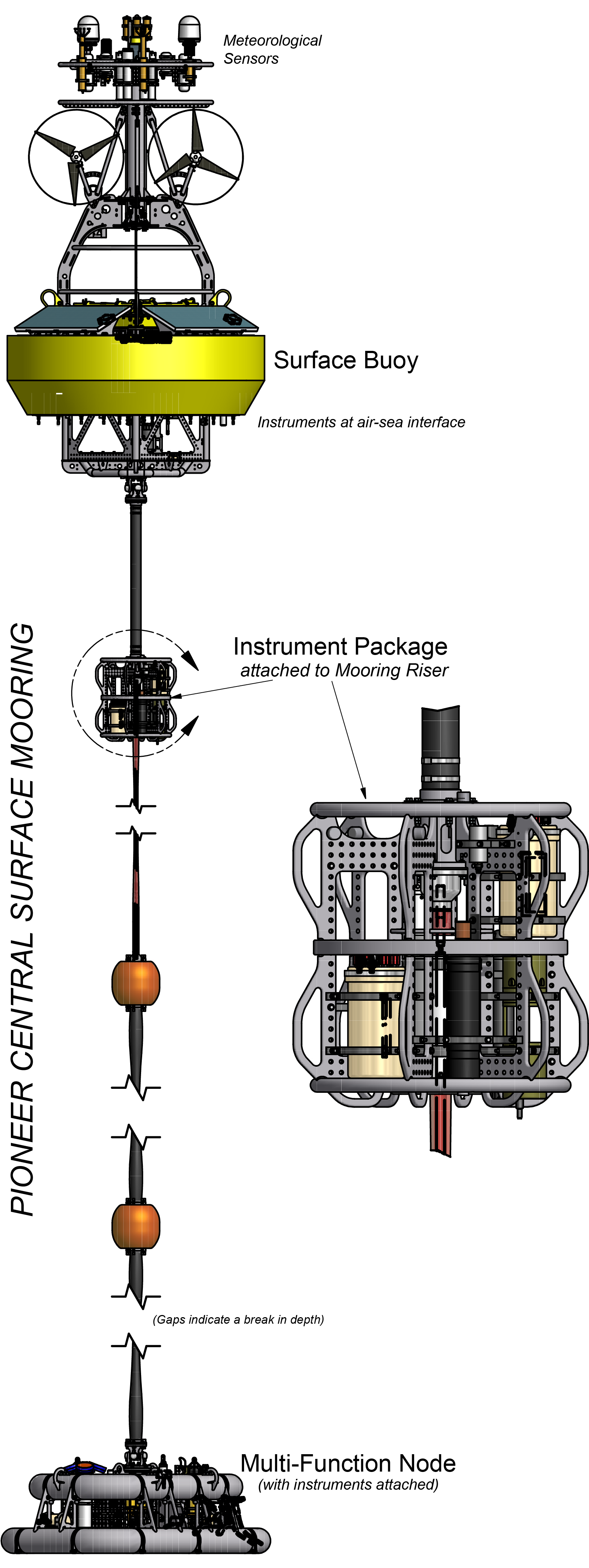 Components used to collect and transmit ocean observations to shore.[/caption]
Components used to collect and transmit ocean observations to shore.[/caption]
Pioneer offshore https://mariners.neracoos.org/platform/44077
Pioneer central: https://mariners.neracoos.org/platform/44076
Pioneer inshore: https://mariners.neracoos.org/platform/44075
“We are pleased to see the Pioneer Array data being made more widely available through the Mariners’ Dashboard to help provide information about current ocean conditions,” said Al Plueddemann, head of the Ocean Observatories Initiative Coastal and Global Surface Nodes team, which includes the Pioneer Array. “This is just one example of how OOI data, which are freely available to anyone with an Internet connection, are being put to good use.”
Read More
Applications Open for Larry P. Atkinson Travel Fellowship
Do you need travel funds to attend and present your OOI research at a conference?
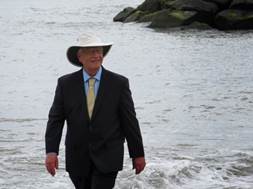 Larry P. Atkinson[/caption]
Larry P. Atkinson[/caption]
The Larry P. Atkinson Travel Fellowship for Students and Early Career Scientists online application is now open!
If you need funding to offset conference expenses (registration fees, travel costs, accommodations, etc.), we encourage you to apply. Conference participation can be in-person or virtual. Information on eligibility requirements, and how to apply, are available here.
Demo of Data Explorer 1.1 Video
Data Explorer continues to be refined in response to data users’ suggestions. Upcoming updates and refinements are previewed in this 55-minute video. The new, improved site will launch 5 May 2021. Look for it!
[embed]https://youtu.be/WhXgQ5qe78E[/embed] Read More
A Bountiful Sea of Data: Making Echosounder Data More Useful
[media-caption path="https://oceanobservatories.org/wp-content/uploads/2021/03/Screen-Shot-2021-03-30-at-5.51.41-PM.png" link="#"]Researchers used echosounder data from the Oregon Offshore site of the Coastal Endurance Array to develop a new methodology that makes it easier to extract dominant patterns and trends.[/media-caption]The ocean is like a underwater cocktail party. Imagine, as a researcher, trying to follow a story someone is telling while other loud conversations are in the background of a recording. This phenomenon, known as the “Cocktail Party Problem,” has been studied since the 1950s (Cherry, 1953; McDermott, 2009). Oceanographers face this challenge in sorting through ocean acoustics data, with its mixture of echoes from acoustic signals sent out to probe the ocean.
Oceanographer Wu-Jung Lee and data scientist Valentina Staneva, at the University of Washington, teamed up to tackle the challenge in a multidisciplinary approach to analyze the vast amounts of data generated by echosounders on Ocean Observatories Initiative (OOI) arrays. Their findings were published in The Journal of the Acoustical Society of America, where they proposed a new methodology that uses machine learning to parse out noisy outliers from rich echosounder datasets and to summarize large volumes of data in a compact and efficient way.
This new methodology will help researchers use data from long time series and extract dominant patterns and trends in sonar echoes to allow for better interpretation of what is happening in the water column.
The ocean is highly dynamic and complex at the Oregon Offshore site of the OOI Coastal Endurance Array, where echosounder data from a cabled sonar were used in this paper. At this site, zooplankton migrate on a diurnal basis from a few hundred meters to the surface, wind-stress curl and offshore eddies interact with the coastal circulation, and a subsurface undercurrent moves poleward. The echosounder data offer opportunities to better understand the animals’ response to immediate environmental conditions and long-term trends. During the total eclipse of the Sun in August 2017, for example, echosounders captured the zooplankton’s reaction to the suddenly dimmed sunlight by moving upwards as if it was dusk time for them to swim toward the surface to feed (Barth et al, 2018).
Open access of echosounder datasets from the OOI arrays offers researchers the potential to study trends that occur over extended stretches of time or space. But commonly these rich datasets are underused because they require significant processing to parse out what is important from what is not.
Echosounders work by sending out pulses of sound waves that bounce off objects. Based on how long it takes for the reflected echo to come back to the sensor, researchers can determine the distance of the object. That data can be visualized as an echogram, an image similar to an ultrasound image of an unborn baby.
But unlike an ultrasound of a baby, when an undersea acoustic sensor records a signal, it may be a combination of signals from different sources. For example, the signal might be echoes bouncing off zooplankton or schools of fish.
[caption id="attachment_20566" align="alignleft" width="350"] (A) Data used in this work were collected by a three-frequency echosounder installed on a Regional Cabled Array Shallow Profiler mooring hosting an underwater platform (200 m water depth) and profiler science pod located at the Oregon Offshore site of the OOI Coastal Endurance Array (red triangle). The symbols indicate the locations of all OOI echosounders installed along the coast of Oregon and Washington. (B) The transducers are integrated into the mooring platform (from left to right: 120, 200, and 38 kHz). The platform also hosts an instrumented profiler that traverses the water column above the echosounder from ~ 200 m to ~ 5m beneath the ocean’s surface. (Image credit: UW/NSF-OOI/WHOI-V15).[/caption]
(A) Data used in this work were collected by a three-frequency echosounder installed on a Regional Cabled Array Shallow Profiler mooring hosting an underwater platform (200 m water depth) and profiler science pod located at the Oregon Offshore site of the OOI Coastal Endurance Array (red triangle). The symbols indicate the locations of all OOI echosounders installed along the coast of Oregon and Washington. (B) The transducers are integrated into the mooring platform (from left to right: 120, 200, and 38 kHz). The platform also hosts an instrumented profiler that traverses the water column above the echosounder from ~ 200 m to ~ 5m beneath the ocean’s surface. (Image credit: UW/NSF-OOI/WHOI-V15).[/caption]
“When the scatterers are of different size, they will reflect the sound at different frequencies with different strengths,” said Lee. “So, by looking at how strong an echo is at different frequencies, you will get an idea of the range of sizes that you are seeing in your echogram.”
Current echogram analysis commonly requires human judgement and physics-based models to separate the sources and obtain useful summary statistics. But for large volumes of data that span months or even years, that analysis can be too much for a person or small group of researchers to handle. Lee and Staneva’s new methodology utilizes machine learning algorithms to do this inspection automatically.
“Instead of having millions of pixels that you don’t know how to interpret, machine learning reduces the dataset to a few patterns that are easier to analyze,” said Staneva.
Machine learning ensures that the analysis will be data-driven and standardized, thus reducing the human bias and replicability challenges inherently present in manual approaches.
“That’s the really powerful part of this type of methodology,” said Lee. “To be able to go from the data-driven direction and say, what can we learn from this dataset if we do not know what may have happened in a particular location or time period.”
Lee and Staneva hope that by making the echosounder data and analytical methods open access, it will improve the democratization of data and make it more usable for everybody, even those who do not live by the ocean.
In the future, they plan to continue working together and use their new methodology to analyze the over 1000 days of echosounder data from the OOI Endurance Coastal and Regional Cabled Array region.
References
Lee, W-J and Staneva, V (2021).Compact representation of temporal processes in echosounder time series via matrix decomposition. Special Issue on Machine Learning in Acoustics. The Journal of the Acoustical Society of America.
Barth JA, Fram JP, et al. (2018). Warm Blobs, Low-Oxygen Events, and an Eclipse: The Ocean Observatories Initiative Endurance Array Captures Them All.Oceanography, Vol 31.
McDermott, J (2009). The Cocktail Party Problem.Current Biology, Vol 19, Issue 22.
Cherry EC (1953). Some Experiments on the Recognition of Speech, with One and Two Ears.The Journal of the Acoustical Society of America. Vol. 25, No.5.
Read More
Spring Expeditions: Keeping OOI Arrays Fully Operational
OOI teams were in the water on opposite coasts in late March to service the Pioneer and Endurance Arrays. The teams will “turn” the moorings (recover old and deploy new) to keep the arrays continually collecting and reporting data back to shore. This is the 14th turn of the Endurance Array; the 16th for the Pioneer Array.
The Endurance 14 Team set sail from Newport Oregon aboard the R/V Sikuliaq on 24 March for a 15-day expedition. The Pioneer 16 Team departed from Woods Hole, MA, a few days later on 29 March aboard the R/V Armstrong for a 21-day mission. Both expeditions will require two legs because of the need to transport a huge amount of equipment. The equipment for the Pioneer Array weighs more than 129 tons. The Endurance equipment tops the scale at 95 tons.
Departures for both teams occurred after arranging for reduced occupancy on site and social distancing during preparation, followed by 14 days of quarantine to meet COVID-19 restrictions. And while onboard, COVID has necessitated other changes ranging from smaller science parties to scheduled meal times to allow for social distancing.
“It is very impressive that the OOI team has been able to continue to service these arrays in spite of the challenges presented by COVID,” said Al Plueddemann, Chief Scientist of the Pioneer 16 Expedition. “The ocean is a tough environment in which to keep equipment operational, even in normal times. This year, in particular, has required both our shore-based staff and those onboard to be adaptable, flexible, and innovative to get the job done.”
[media-caption path="https://oceanobservatories.org/wp-content/uploads/2021/03/burnin_Travis.jpg" link="#"]The full cycle of preparation for an OOI mooring service cruise takes many months. The “burn-in” period for Pioneer-16, during which equipment is assembled and tested, began in January 2021 with snow on the ground outside of the LOSOS building on the WHOI campus. Credit:Rebecca Travis © WHOI.[/media-caption]In addition to the mooring and deployment recoveries, both teams are deploying and recovering gliders that collect additional data within the water column and the area between the moorings. They also are conducting CTD casts and water sampling at the mooring sites, and doing meteorological comparisons between ship and buoys. The Pioneer Team will be operating autonomous underwater vehicles (AUVs), while the Endurance Team will have its inaugural use of OOI’s own remotely operated vehicle (ROV) to recover anchors at the Oregon shelf site.
“In normal times, we would invite external students and scientists along to conduct ancillary experiments on the cruise,” said Edward Dever, Chief Scientist for Endurance 14. “But given the limited science party allowed onboard due to COVID-19, the OOI team will be conducting some of this additional work to ensure the continuity of these experiments.”
For Endurance 14, this work includes collection of organisms that grow on panels attached to Endurance buoys for invasive species research, collection of settling organisms on devices attached to Multi-Function Nodes, which power near bottom data instruments, and test deployments of tagged fish acoustic monitors on near surface instrument frames on three moorings.
Likewise, the Pioneer 16 Team is helping ensure ongoing science investigations installing and operating unattended underway sampling for the Northeast U.S. Shelf Long-Term Ecological Research (LTER) project and conducting CTD casts at LTER sites during the cruise. They will also conduct communication tests at the Offshore mooring site in support of the Keck-funded 3-D Acoustic Telescope project.
Science teams of 9-10 people on each cruise are sharing the multitude of tasks needed for the moored array service.
[media-caption path="https://oceanobservatories.org/wp-content/uploads//2021/03/Screen-Shot-2021-04-01-at-9.19.20-AM.png" link="#"]OOI’s remotely operated vehicle will be used for the first-time during Endurance 14. Credit: Seaview Systems.[/media-caption]
Read More

